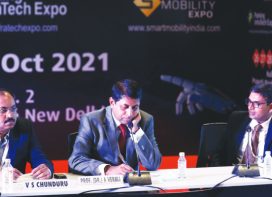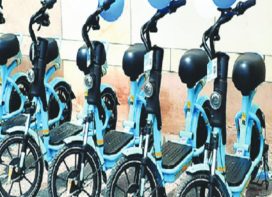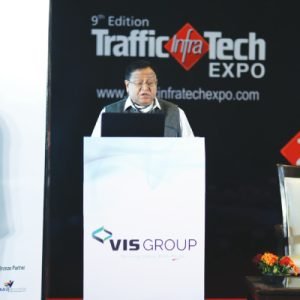
Dr. Vijay Kumar Saraswat, Member, NITI Aayog, and Chancellor, Jawaharlal Nehru University
Making the keynote address at the inaugural session of the TrafficInfraTech, Expo, Dr. Vijay Kumar Saraswat, Member, NITI Aayog, and Chancellor, Jawaharlal Nehru University, threw insights on traffic and transport technology, and how newer technologies are pacing the infrastructure segment and fuelling huge investments & commercial gains for the country
India has the second largest road network in the world spanning a total of 5.89 million kms, and highway construction in the country has increased at 17% CAGR between FY16 and FY21, thanks to Hon’ble Minister Nitin Gadkari and his team who have been responsible for this immense progress.
Despite the pandemic and the lockdown India has constructed almost 13,298 kms of highways in FY21 which attracted foreign direct investment inflow worth about 26.08 billion dollars in between April 2000 and March 2021.
A major programme is Bharatmala Pariyojana, where the Ministry and myself approved implementation of more than 34,800 kms of national highways in five years with an outlay of 5,35,000 Cr.
Comprehensive Strategies
The government through a series of initiatives is working on policies to attract significant investor-interest. A total of 200,000 kms of national highways is expected to be completed by 2022. In the next five years, the National Highways Authority of India will be able to generate 100,000 Cr, approximately $ 14.3 billion annually from toll and other sources.
As per media reports, the drivers in Delhi spend around 58% percent more time in traffic as compared to the drivers in any other city in the world. IIT Madras reported that 50% of the cost-deduction can be achieved by making infrastructural change like dedicated bus lanes and using smart traffic management systems. The Delhi Government is now employing ITMS that has imbibed tools like artificial intelligence, machine learning and data analysis. Around 7500 CCTV cameras, automatic traffic lights and about 1000 LED signs with sensors and cameras will be installed in the city. Again, Mumbai is set to get about Rs.891Cr smart traffic management systems on the basis of dynamic traffic data captured by the system software. The city traffic police will be able to modify signal timings and regulate flow at almost 617 junctions.
Growth Drivers
It is expected traffic volume to double, about 2 billion by 2040 fuelled by increased urbanisation that will exacerbate the multibillion annual cost of congestion across large cities. Also, there is a new monetisation model called e-tolling that transportation authorities around the world are implementing.
There will be evolving funding models too where cities and transportation authorities shall highly rely on public-private partnerships to increase project efficiency, share risks and minimize the road closure times.
All of us are now talking about autonomous driving in which new technologies may be improved in a monitored, low latency environment and 5G is going to be a major component in the edge computing devices on roadside units and intersections. The connected vehicle technology for improving road safety will require edge computing, work load consolidation, data management and communication networks.
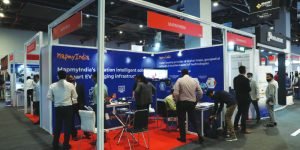
Benefits of smart roads & infrastructure
One notable impact will be the less congested streets where smart road technology can track vehicles and adjust the traffic lights accordingly, helping prevent bumper to bumper traffic.
Improved traffic and pedestrian safety will prove to be an advantage, where the solutions would be powered by computer vision that can detect vehicles, pedestrians and bicyclists to help enable safety practices.
Enhanced parking and e-tolling using licence plate recognition and vehicle tracking will help reduce congestion without making vehicles stop or slow down.
Smart infrastructure will help reduce carbon emissions from daily transportation by optimising traffic flow to avoid idling engines.
Cities can also help reduce pollution by placing electric charging stations strategically.
Smart, next generation technologies
The intelligent transportation system market is presently almost about $40 billion and is expected to rise to 70 billion by 2026, globally.
One smart technology, Intel Edge services, aids in transmitting traffic information to oncoming vehicles and identifying potential risks ahead. The entire services help improve the agility of automated vehicles, vehicle safety and overall flow of the traffic on highways.
Intel’s electronic toll collection system, similarly, intelligent traffic management system and Hitachi’s solutions are working towards smart sensors for road infrastructure. The systems provide real-time data analytics and storage at the edge to improve traffic with smart cameras.
Let us look at some of the next generation technologies.
— Solar powered roadways where photovoltaic cells are embedded within hexagonal panels made of tempered glass which is used to pave the roads
— Smart roads, specially engineered roadways fitted with smart features including sensors that monitor and report changing road conditions
— Glow-in-the-dark roads, glowing markers painted on the existing roadway surfaces use a photo luminescent powder that absorbs and throws daylight
— Interactive lights, road lights activated by motion sensors to illuminate a particular section of the road as the cars approach
— Electric priority lane for charging electric vehicles, embedded cables generate magnetic fields that charge electric vehicles while driving. This future wireless technology could charge batteries while in motion
— Weather detection, networks of AI integrated sensors detect weather conditions that impact the road safety
— Traffic detection sensors lining the highways monitor traffic flow and weight load, warn drivers of traffic jams, and automatically alert the authorities about accidents.
Shaping the Future
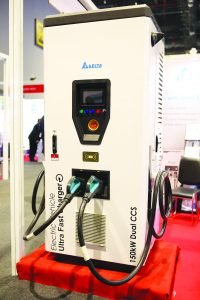 There are eight forces that will shape the future and national digital transformation. One is the rise of the sharing economy; it is changing the way a city functions. The production and supply chain landscape will be dramatically changed by Industry 4.0 with the block chain taking the front seat. And artificial intelligence will penetrate almost every aspect of life and change the way a city functions. Digital identities will allow people and things to thrive in the new smart city paradigm and future cities will have digital twins of themselves to enable the move towards cognitive cities.
There are eight forces that will shape the future and national digital transformation. One is the rise of the sharing economy; it is changing the way a city functions. The production and supply chain landscape will be dramatically changed by Industry 4.0 with the block chain taking the front seat. And artificial intelligence will penetrate almost every aspect of life and change the way a city functions. Digital identities will allow people and things to thrive in the new smart city paradigm and future cities will have digital twins of themselves to enable the move towards cognitive cities.
Urban predictive operations will enable city operations to be predictive rather than reactive and cities to provide personalized and immersive experiences to citizens, residents and visitors. The foundation of future smart cities would be built on digital infrastructure. 5Gnetworks are going to be integrated on the smart traffic city system. Like it will help in intelligent traffic lights, make infotainment service and infrastructure, provide roads service for autonomous driving vehicles, give security with cooperative intelligent transport systems, provide infrastructure services for vehicular communication services and it will also ensure vehicles data traffic management and emergency transportation services.
Now there are various methods by which these functions are being done but the most important sensor is Lidar, a laser based radar system. Today, we are using GPS which is not able to differentiate between pedestrians and cyclists; we are also using cameras that do data generation in 2D related to data protection as far as the camera is concerned. We also use radars for collecting the speed information, high speed detection but are missing the level of detailed objects. Whereas in Lidar, it is a detailed and reliable 3D information that you can get; you can get the shape, size, everything of the vehicle. Accurate speed detection is possible in this case and very precise differentiation between all road users. So that is why Lidar is going to overtake all the kinds of sensors which are going to come on the smart city infrastructure or roadways.
When it comes to Parking, sensors can detect whether a parking space is occupied or vacant. Number two, sensors can transmit data to a central server, then smart phone app requests a parking space and guides drivers to the free space and parking fee is paid directly through the apps. Special permits, parking, and local resident IDs, permits for taxis and coaches are provided. And of course, legitimation, access control to restricted traffic areas such as loading zones and pedestrian zones.
What are the smart traffic solution needs for India. ?
One is developing junction control system to communicate with each other through wireless connection for signal coordination and network optimisation. We need vehicle counting system capable of counting vehicles passing through a particular road section.
Junction control unit is a high speed processor which allows analysing collection data from various sensors in real time and runs the customised algorithms inside. The data will be used in real time for signal optimisation and artificial intelligence-based video recognition helps smart traffic control.
Diversified integration services, data collection and smart control.
Today, we are wishing that all our toll plazas become barrier-less with automatic number plate recognition which will enable increase the speed, reduce pollution, reduce cost and enable online payment preregistered with license plate number. ANPR can enable post usage payment within time limit of 48 hours, entry and exit checks and average travel speed calculations.
Artificial intelligence enabled infringement detection system installed in dedicated emergency lane for ambulance, police and fire tender vehicles detect and identify cars through the number plate recognition and issue fines directly through the payment system if you are in the emergency lane when you are not supposed to be there.
Similarly, AI enabled smart parking system and AI enabled real time traffic monitoring system.
Gas based economy
Besides roads and electric vehicles, the transition we are now talking about, is a gas based economy through the bio-CNG and CNG kind of a thing. We also have a target of 20% for blended gasoline and petrol with ethanol by 2025.
In addition to that I am also talking about the introduction of methanol blending, 50 percent methanol in an existing E10 petrol. E10 petrol mixed with M15 becomes a solution for you and overall saving is 25 percent on your petrol.
Increased use of bio-CNG through increased production, adaptation and distribution network. Actually, if you want to really include the CNG into the system you have to cater for its higher production, it’s adaptation and distribution network. Today one of the major bottlenecks is the distribution network of CNG.
One other major measure should be for 2-wheelers, 3-wheelers and 4-wheelers and even some of the commercial vehicles like trucks. M15 which is 15% blend of methanol with petrol, gives 35 percent reduction in the greenhouse gas emissions. Replacing diesel by M100, which is 100 percent methanol, can lead to almost about 70 percent reduction in the emissions. Another solution- methanol is a carrier of hydrogen and using a methanol reformer, it can be reformed to hydrogen which can be used to run a fuel cell. That means you have a hydrogen vehicle with methanol as the carrier instead of pressurised hydrogen or hydrogen as a bulk carrier because, in terms of volume density, you are able to make use of methanol as a carrier. So hydrogen will be used as a fuel to power the fuel cell and that gives you the e-mobility.
Challenges in e- mobility
We all know that the problems of e-mobility are that only a fraction of transport can be fully battery operated. By 2030, about 30 to 40 percent of the cars will be battery operated, the commercial vehicles will be about 2 to 3 percent, marine systems and aircrafts will be only about zero percent.
We also have to manage the intermittency of solar and EV charging stations. The main problem there is that most of the EV charging stations today are fed by the grid for electricity. So, overall gain in terms of emissions is not there. Instead of distributed emissions, we now have increased requirement of power from the thermal power stations, which means our grid is not completely decarbonised and if so, it does not impact positively as far as the emissions are concerned; actually emissions will continue to rise.
So the challenge to ramp up sustainable battery production is another requirement. New car registrations in 2019 were 21 million and if the battery requirement of new cars is taken, you will have to put in about 2100 Gigawatt hours of battery supply, that is the kind of estimate we have.
So, the answer is that we should promote fuel cell and electric vehicles together, promote methanol production from coal, MS and, biomass.
Standard natural gas to be used as a hydrogen carrier for fuel cell based e-mobility. Provide funds and incentives for R&D and production of fuel cells in the country.
With batteries, we have a major problem because battery production is really impacted by the availability of lithium and cobalt. Our country does not have any reserves of lithium and cobalt and we are completely dependent on imports. There is a method by which recycling of lithium batteries can be done but the recycling load will be available only after five years of the use of the battery.
So, in the beginning years, we still have to take fresh battery supplies and for that lithium has to be made available. Otherwise, you will be importing lithium batteries from outside or the cells as we are doing today instead of importing gasoline crude or petrol and diesel. But that does not give you ‘Atmanirbhartha’. We should have our industrial policy for lithium battery recycling, we should also acquire some mines in Bolivia, Chile, or Australia for getting lithium for our fresh supplies.
The main thing is to bring down the cost of all these systems for which we should scale fuel cell production to 200,000 units which can reduce unit cost by as much as 45 percent. Further increase to 600,000 units correspond to about 70 percent cost reduction as has happened in the case of batteries. I think the scale is going to make a difference as far as the fuel cells are concerned.
Same is the case for green hydrogen to be produced by electrolysis of water. So you need electrolysers. The cost will come down to $300 per kilowatt with a terawatt installed capacity and $130 per kilowatt with a 5 terawatt installed capacity. Another thing is the flexible fuel vehicles which the Minister Gadkari Ji has been talking as flex fuels in which methanol, ethanol, petrol, all of them can be used and that should also be developed. North Eastern states where ethanol is not available, they should switch over to methanol systems.
Hybrid vehicles is my answer for meeting the requirements of this particular transition- what we have from gasoline system to a complete e-vehicle module.
 TrafficInfraTech Magazine Linking People Places & Progress
TrafficInfraTech Magazine Linking People Places & Progress
